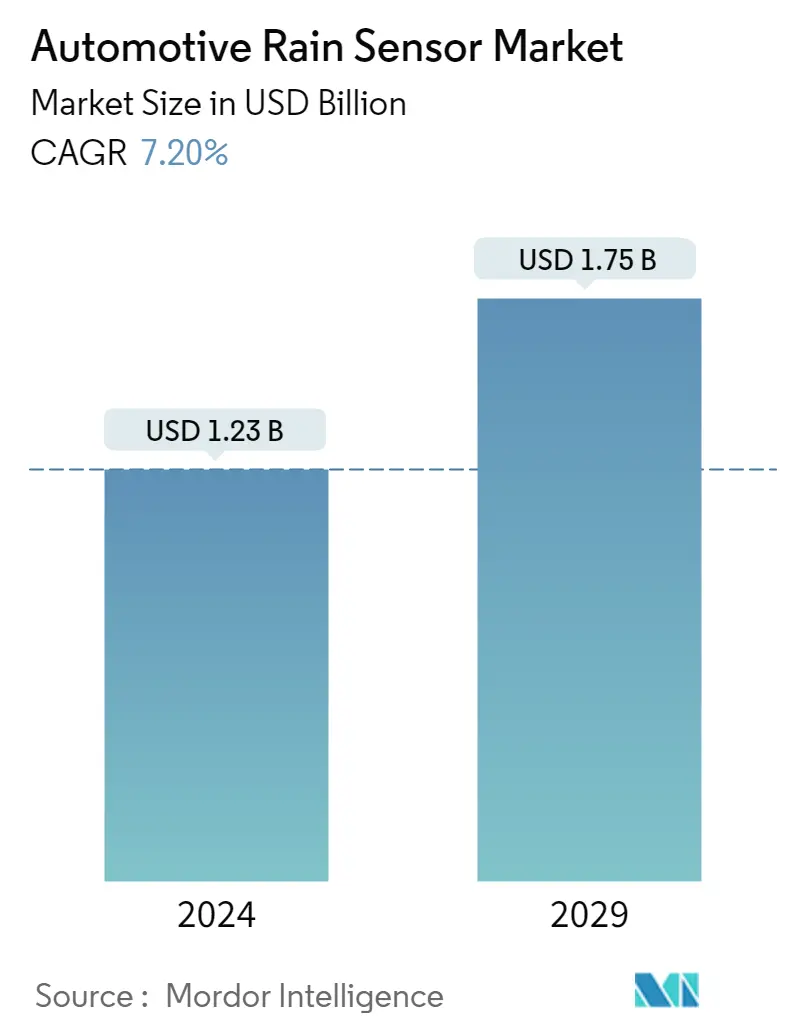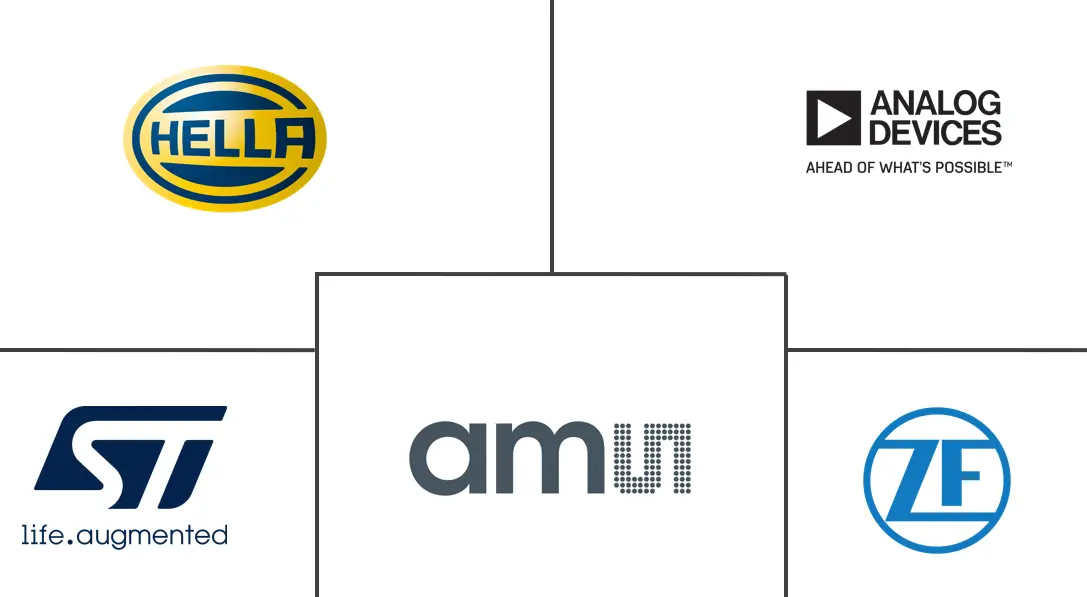Market Size of Automotive Rain Sensor Industry

| Study Period | 2019 - 2029 |
| Market Size (2024) | USD 1.23 Billion |
| Market Size (2029) | USD 1.75 Billion |
| CAGR (2024 - 2029) | 7.20 % |
| Fastest Growing Market | Asia-Pacific |
| Largest Market | Asia-Pacific |
Major Players
*Disclaimer: Major Players sorted in no particular order |
Automotive Rain Sensors Market Analysis
The Automotive Rain Sensor Market size is estimated at USD 1.23 billion in 2024, and is expected to reach USD 1.75 billion by 2029, growing at a CAGR of 7.20% during the forecast period (2024-2029).
The market was negatively affected by the COVID-19 pandemic in 2020 due to low-reported vehicle sales impacting the commercial potential for automotive rain sensors in the wake of a decline in vehicle production and supply chain disruptions. However, by the first half of 2021, the market had gained momentum as electric vehicle sales picked up across major regions globally.
The increasing use of electrical systems in cars and the expanding need for driver comfort and safety in vehicles, coupled with significant expansion of the automotive sector, are anticipated to act as major driving factors for market growth during the forecast period. In addition, the development of electric mobility and autonomous vehicle technology is expected to further contribute to the remarkable growth of the automotive rain sensors market. Moreover, improving economic conditions, increasing customer demand and interest, technical innovation, and stricter government restrictions are all favorable drivers for the market's expansion. Furthermore, leading luxury vehicle manufacturers are introducing electric variants of their vehicles in response to growing environmental concerns and rising fuel prices. It will also aid in the expansion of the sector. Due to the lower cost of automotive rain sensors, adopting such sensors in the economy and mid-range automobiles is expected to enhance market growth.
In general, several nations advise putting a rain sensor on cars because of excessive rain. However, there are some places where it might not even be necessary. The Middle East & North Africa are two places with very little rainfall. Some nations, such as Qatar, Saudi Arabia, the United Arab Emirates, Kuwait, and Egypt, have extremely low levels of precipitation, which lessens the need for automatic rain sensors. For example, rainfall is negligible in all seasons of the Middle East, as the region is nearly all desert. The only real winters in the Middle East happen in the mountainous regions of Saudi Arabia, where temperatures can reach freezing. Such typical climatic conditions discourage key OEMs from launching their models with such automatic rain-sensing technology features and hence are anticipated to limit the overall market development over the forecast period.
In most parts of North America, automatic wipers are already commonplace in vehicles and have advanced across most car segments. Rain sensors that manage the speed and frequency of wipers are not only a convenience feature, but they are also thought to make driving safer. In all weather situations, the proper wiper speed ensures optimal visibility. According to automakers, the rain sensor's location behind the rearview mirror is also perfect for a cluster of sensors, such as a camera, sun sensor, and ambient light sensor.
Automotive Rain Sensors Industry Segmentation
The rain sensor device in an automotive vehicle detects rain on the windshield. The sensor detects water on the windshield using a control module with an LED. When the glass becomes wet, less light enters the sensor. When the amount of light reflected onto the sensor reaches a certain threshold, the software in a rain-sensing system activates the wipers. Furthermore, the speed and duration of wiper activation depend on the windscreen wetness ratio and are controlled by these sensor modules.
The automotive rain sensors market has been segmented by vehicle type and geography.
By vehicle type, the market has been segmented into passenger cars and commercial vehicles. By geography, the market has been segmented into North America, Europe, Asia-Pacific, and the Rest of the world.
The report also covers the market size and forecast for the automotive rain sensors market across the regions mentioned. For each segment, the market sizing has been done in terms of value (USD billion).
| By Vehicle Type | |
| Passenger Cars | |
| Commercial Vehicles |
| By Geography | ||||||||
| ||||||||
| ||||||||
| ||||||||
|
Automotive Rain Sensor Market Size Summary
The automotive rain sensors market is poised for significant growth over the forecast period, driven by the increasing integration of electrical systems in vehicles and the rising demand for enhanced driver comfort and safety. The market, which experienced a downturn due to the COVID-19 pandemic, has rebounded with the surge in electric vehicle sales globally. The expansion of the automotive sector, coupled with advancements in electric mobility and autonomous vehicle technology, is expected to further propel market growth. Economic improvements, heightened consumer interest, and stricter government regulations are also contributing to the market's positive trajectory. The adoption of rain sensors in economy and mid-range vehicles is anticipated to boost market expansion, despite regional variations in demand due to climatic conditions.
Regionally, Asia-Pacific is expected to dominate the market, driven by the economic growth of countries like China and India, which is likely to increase passenger car demand. The region's focus on infrastructure development and industrialization is also expected to enhance the market's growth prospects. Europe is projected to be the fastest-growing region, with Germany leading due to its robust automotive industry and adoption of advanced technologies. The market is characterized by consolidation, with major players engaging in product innovation and strategic partnerships to maintain their competitive edge. Collaborations and technological advancements, such as those by HELLA and ZF Friedrichshafen, are expected to further enhance the capabilities and applications of automotive rain sensors, supporting the market's expansion.
Automotive Rain Sensor Market Size - Table of Contents
-
1. MARKET DYNAMICS
-
1.1 Market Drivers
-
1.2 Market Restraints
-
1.3 Porter's Five Forces Analysis
-
1.3.1 Threat of New Entrants
-
1.3.2 Bargaining Power of Buyers/Consumers
-
1.3.3 Bargaining Power of Suppliers
-
1.3.4 Threat of Substitute Products
-
1.3.5 Intensity of Competitive Rivalry
-
-
-
2. MARKET SEGMENTATION
-
2.1 By Vehicle Type
-
2.1.1 Passenger Cars
-
2.1.2 Commercial Vehicles
-
-
2.2 By Geography
-
2.2.1 North America
-
2.2.1.1 United States
-
2.2.1.2 Canada
-
2.2.1.3 Mexico
-
2.2.1.4 Rest of North America
-
-
2.2.2 Europe
-
2.2.2.1 Germany
-
2.2.2.2 United Kingdom
-
2.2.2.3 France
-
2.2.2.4 Russia
-
2.2.2.5 Spain
-
2.2.2.6 Rest of Europe
-
-
2.2.3 Asia-Pacific
-
2.2.3.1 India
-
2.2.3.2 China
-
2.2.3.3 Japan
-
2.2.3.4 South Korea
-
2.2.3.5 Rest of Asia-Pacific
-
-
2.2.4 Rest of World
-
2.2.4.1 Brazil
-
2.2.4.2 Saudi Arabia
-
2.2.4.3 United Arab Emirates
-
2.2.4.4 South Africa
-
2.2.4.5 Rest of World
-
-
-
Automotive Rain Sensor Market Size FAQs
How big is the Automotive Rain Sensor Market?
The Automotive Rain Sensor Market size is expected to reach USD 1.23 billion in 2024 and grow at a CAGR of 7.20% to reach USD 1.75 billion by 2029.
What is the current Automotive Rain Sensor Market size?
In 2024, the Automotive Rain Sensor Market size is expected to reach USD 1.23 billion.

